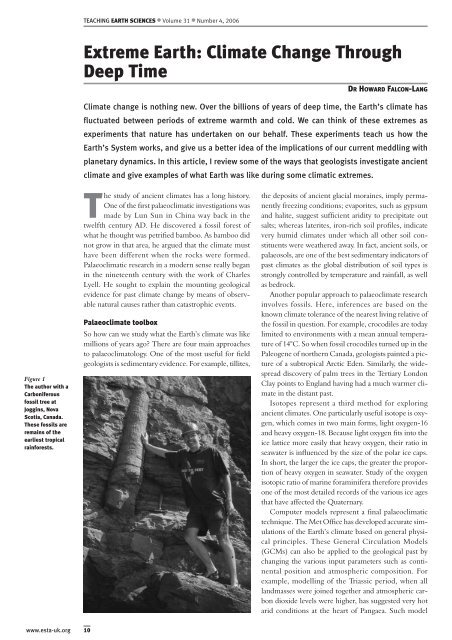teaching - Earth Science Teachers' Association
teaching - Earth Science Teachers' Association
teaching - Earth Science Teachers' Association
You also want an ePaper? Increase the reach of your titles
YUMPU automatically turns print PDFs into web optimized ePapers that Google loves.
TEACHING EARTH SCIENCES ● Volume 31 ● Number 4, 2006<br />
Extreme <strong>Earth</strong>: Climate Change Through<br />
Deep Time<br />
DR HOWARD FALCON-LANG<br />
Climate change is nothing new. Over the billions of years of deep time, the <strong>Earth</strong>’s climate has<br />
fluctuated between periods of extreme warmth and cold. We can think of these extremes as<br />
experiments that nature has undertaken on our behalf. These experiments teach us how the<br />
<strong>Earth</strong>’s System works, and give us a better idea of the implications of our current meddling with<br />
planetary dynamics. In this article, I review some of the ways that geologists investigate ancient<br />
climate and give examples of what <strong>Earth</strong> was like during some climatic extremes.<br />
Figure 1<br />
The author with a<br />
Carboniferous<br />
fossil tree at<br />
Joggins, Nova<br />
Scotia, Canada.<br />
These fossils are<br />
remains of the<br />
earliest tropical<br />
rainforests.<br />
The study of ancient climates has a long history.<br />
One of the first palaeoclimatic investigations was<br />
made by Lun Sun in China way back in the<br />
twelfth century AD. He discovered a fossil forest of<br />
what he thought was petrified bamboo. As bamboo did<br />
not grow in that area, he argued that the climate must<br />
have been different when the rocks were formed.<br />
Palaeoclimatic research in a modern sense really began<br />
in the nineteenth century with the work of Charles<br />
Lyell. He sought to explain the mounting geological<br />
evidence for past climate change by means of observable<br />
natural causes rather than catastrophic events.<br />
Palaeoclimate toolbox<br />
So how can we study what the <strong>Earth</strong>’s climate was like<br />
millions of years ago? There are four main approaches<br />
to palaeoclimatology. One of the most useful for field<br />
geologists is sedimentary evidence. For example, tillites,<br />
the deposits of ancient glacial moraines, imply permanently<br />
freezing conditions; evaporites, such as gypsum<br />
and halite, suggest sufficient aridity to precipitate out<br />
salts; whereas laterites, iron-rich soil profiles, indicate<br />
very humid climates under which all other soil constituents<br />
were weathered away. In fact, ancient soils, or<br />
palaeosols, are one of the best sedimentary indicators of<br />
past climates as the global distribution of soil types is<br />
strongly controlled by temperature and rainfall, as well<br />
as bedrock.<br />
Another popular approach to palaeoclimate research<br />
involves fossils. Here, inferences are based on the<br />
known climate tolerance of the nearest living relative of<br />
the fossil in question. For example, crocodiles are today<br />
limited to environments with a mean annual temperature<br />
of 14°C. So when fossil crocodiles turned up in the<br />
Paleogene of northern Canada, geologists painted a picture<br />
of a subtropical Arctic Eden. Similarly, the widespread<br />
discovery of palm trees in the Tertiary London<br />
Clay points to England having had a much warmer climate<br />
in the distant past.<br />
Isotopes represent a third method for exploring<br />
ancient climates. One particularly useful isotope is oxygen,<br />
which comes in two main forms, light oxygen-16<br />
and heavy oxygen-18. Because light oxygen fits into the<br />
ice lattice more easily that heavy oxygen, their ratio in<br />
seawater is influenced by the size of the polar ice caps.<br />
In short, the larger the ice caps, the greater the proportion<br />
of heavy oxygen in seawater. Study of the oxygen<br />
isotopic ratio of marine foraminifera therefore provides<br />
one of the most detailed records of the various ice ages<br />
that have affected the Quaternary.<br />
Computer models represent a final palaeoclimatic<br />
technique. The Met Office has developed accurate simulations<br />
of the <strong>Earth</strong>’s climate based on general physical<br />
principles. These General Circulation Models<br />
(GCMs) can also be applied to the geological past by<br />
changing the various input parameters such as continental<br />
position and atmospheric composition. For<br />
example, modelling of the Triassic period, when all<br />
landmasses were joined together and atmospheric carbon<br />
dioxide levels were higher, has suggested very hot<br />
arid conditions at the heart of Pangaea. Such model<br />
www.esta-uk.org<br />
10

















